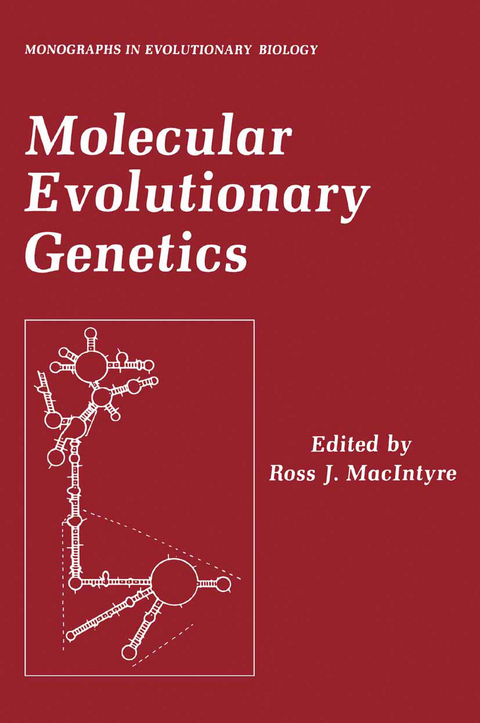
Molecular Evolutionary Genetics
Springer-Verlag New York Inc.
978-1-4684-4990-7 (ISBN)
1 Evolution of DNA Sequences.- 1. Introduction.- 2. Methods for Estimating the Number of Nucleotide Substitutions between Sequences.- 3. Rates of Nucleotide Substitution in Various Regions of Genes.- 4. Molecular Clock.- 5. Patterns of Nucleotide Substitution in Pseudogenes and Functional Genes.- 6. Nonrandom Usage of Synonymous Codons.- 7. Concerted Evolution of Multigene Families.- 8. Mechanisms of DNA Evolution.- 9. Concluding Remarks.- References.- 2 The Mitochondrial Genome of Animals.- 1. Introduction.- 2. Structure, Content, and Function in Animal Mitochondrial DNA.- 3. Sequence Variation in Animal Mitochondrial DNA.- 4. Rates of Change in Animal Mitochondrial DNA.- 5. Speculations, Problems, and Prospects.- References.- 3 Evolution of Chloroplast and Mitochondrial DNA in Plants and Algae.- 1. Introduction.- 2. Chloroplast Genome Evolution.- 3. Chloroplast Gene Evolution.- 4. Mitochondrial DNA Evolution.- 5. Phylogenese Implications of Organelle DNA Variation.- 6. Summary Comparison of Chloroplast and Mitochondrial DNA Evolution.- References.- 4 Localized Highly Repetitive DNA Sequences in Vertebrate and Invertebrate Genomes.- 1. Introduction.- 2. The Molecular and Biological Data Base: Vertebrates.- 3. The Molecular and Biological Data Base: Invertebrates.- 4. Data Summary.- 5. Epilogue.- 6. Conclusions.- References.- 5 The Evolution of Interspersed Repetitive DNA Sequences in Mammals and Other Vertebrates.- 1. Introduction.- 2. Background.- 3. RNA Pseudogenes.- 4. The Alu Family and Its Allies.- 5. Non-Alu-Family Interspersed Repeats.- 6. Biological Functions and Effects.- 7. Summary.- References.- 6 The Contributions of Retroviruses to the Study of Mammalian Evolution.- 1. Introduction.- 2. Isolation of Primate Retroviruses.- 3. Phylogeny of Primates as Indicated by DNA-DNA Hybridization.- 4. Evolution of Primate Retrovirus Genes.- 5. Endogenous Mammalian Retroviruses.- 6. Interspecies Transmission and Germ Line Integration of Mammalian Retroviruses.- 7. Interspecies Transmission of Infectious Retroviruses.- 8. Conclusion.- References.- 7 Evolution of Ribosomal DNA.- 1. Origin of Genes for the Translational Apparatus.- 2. Basic Organization of rDNA.- 3. Evolutionary Conservation in rRNA Structure.- 4. Processing of rRNA.- 5. Nontranscribed Spacers.- 6. Evolutionary Forces Acting on rDNA.- References.- 8 On the Evolution of Genome Organization in Mammals.- 1. Introduction.- 2. Procedures for Studying Genome Evolution.- 3. The Human Gene Map: An Index Species.- 4. Comparative Genetics and Cytogenetics of Primates.- 5. Comparative Genetics and Cytogenetics of Rodents.- 6. Comparative Genetics and Cytogenetics of Carnivores.- 7. Other Mammalian Families.- 8. Endogenous Retroviruses.- 9. Comparative Genetics of Mammalian Oncogenes.- 10. Conclusions.- References.
| Erscheint lt. Verlag | 13.3.2012 |
|---|---|
| Reihe/Serie | Monographs in Evolutionary Biology |
| Zusatzinfo | 58 Illustrations, black and white; XXII, 632 p. 58 illus. |
| Verlagsort | New York, NY |
| Sprache | englisch |
| Maße | 152 x 229 mm |
| Themenwelt | Medizin / Pharmazie ► Medizinische Fachgebiete ► Mikrobiologie / Infektologie / Reisemedizin |
| Naturwissenschaften ► Biologie ► Botanik | |
| Naturwissenschaften ► Biologie ► Evolution | |
| Naturwissenschaften ► Biologie ► Ökologie / Naturschutz | |
| Naturwissenschaften ► Biologie ► Zoologie | |
| ISBN-10 | 1-4684-4990-7 / 1468449907 |
| ISBN-13 | 978-1-4684-4990-7 / 9781468449907 |
| Zustand | Neuware |
| Haben Sie eine Frage zum Produkt? |
aus dem Bereich


